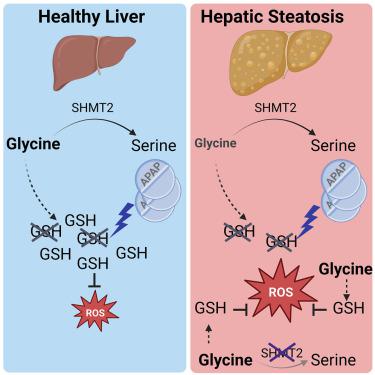当前位置:
X-MOL 学术
›
Cell Metab.
›
论文详情
Our official English website, www.x-mol.net, welcomes your feedback! (Note: you will need to create a separate account there.)
Serine synthesis via reversed SHMT2 activity drives glycine depletion and acetaminophen hepatotoxicity in MASLD
Cell Metabolism ( IF 29.0 ) Pub Date : 2024-01-02 , DOI: 10.1016/j.cmet.2023.12.013 Alia Ghrayeb , Alexandra C. Finney , Bella Agranovich , Daniel Peled , Sumit Kumar Anand , M. Peyton McKinney , Mahasen Sarji , Dongshan Yang , Natan Weissman , Shani Drucker , Sara Isabel Fernandes , Jonatan Fernández-García , Kyle Mahan , Zaid Abassi , Lin Tan , Philip L. Lorenzi , James Traylor , Jifeng Zhang , Ifat Abramovich , Y. Eugene Chen , Oren Rom , Inbal Mor , Eyal Gottlieb
Cell Metabolism ( IF 29.0 ) Pub Date : 2024-01-02 , DOI: 10.1016/j.cmet.2023.12.013 Alia Ghrayeb , Alexandra C. Finney , Bella Agranovich , Daniel Peled , Sumit Kumar Anand , M. Peyton McKinney , Mahasen Sarji , Dongshan Yang , Natan Weissman , Shani Drucker , Sara Isabel Fernandes , Jonatan Fernández-García , Kyle Mahan , Zaid Abassi , Lin Tan , Philip L. Lorenzi , James Traylor , Jifeng Zhang , Ifat Abramovich , Y. Eugene Chen , Oren Rom , Inbal Mor , Eyal Gottlieb

|
Metabolic dysfunction-associated steatotic liver disease (MASLD) affects one-third of the global population. Understanding the metabolic pathways involved can provide insights into disease progression and treatment. Untargeted metabolomics of livers from mice with early-stage steatosis uncovered decreased methylated metabolites, suggesting altered one-carbon metabolism. The levels of glycine, a central component of one-carbon metabolism, were lower in mice with hepatic steatosis, consistent with clinical evidence. Stable-isotope tracing demonstrated that increased serine synthesis from glycine via reverse serine hydroxymethyltransferase (SHMT) is the underlying cause for decreased glycine in steatotic livers. Consequently, limited glycine availability in steatotic livers impaired glutathione synthesis under acetaminophen-induced oxidative stress, enhancing acute hepatotoxicity. Glycine supplementation or hepatocyte-specific ablation of the mitochondrial SHMT2 isoform in mice with hepatic steatosis mitigated acetaminophen-induced hepatotoxicity by supporting glutathione synthesis. Thus, early metabolic changes in MASLD that limit glycine availability sensitize mice to xenobiotics even at the reversible stage of this disease.
中文翻译:

通过反向 SHMT2 活性合成丝氨酸可驱动 MASLD 中的甘氨酸消耗和对乙酰氨基酚肝毒性
代谢功能障碍相关的脂肪肝病 (MASLD) 影响着全球三分之一的人口。了解所涉及的代谢途径可以提供对疾病进展和治疗的见解。对早期脂肪变性小鼠肝脏的非靶向代谢组学发现甲基化代谢物减少,表明一碳代谢发生改变。甘氨酸(一碳代谢的核心成分)水平在患有肝脂肪变性的小鼠中较低,这与临床证据一致。稳定同位素示踪表明,通过反向丝氨酸羟甲基转移酶(SHMT)从甘氨酸合成丝氨酸的增加是脂肪变性肝脏中甘氨酸减少的根本原因。因此,在对乙酰氨基酚诱导的氧化应激下,脂肪肝中有限的甘氨酸可用性会损害谷胱甘肽的合成,从而增强急性肝毒性。在患有肝脂肪变性的小鼠中补充甘氨酸或肝细胞特异性去除线粒体 SHMT2 亚型可通过支持谷胱甘肽合成减轻对乙酰氨基酚诱导的肝毒性。因此,MASLD 的早期代谢变化限制了甘氨酸的可用性,即使在这种疾病的可逆阶段,也会使小鼠对异生素敏感。
更新日期:2024-01-02
中文翻译:

通过反向 SHMT2 活性合成丝氨酸可驱动 MASLD 中的甘氨酸消耗和对乙酰氨基酚肝毒性
代谢功能障碍相关的脂肪肝病 (MASLD) 影响着全球三分之一的人口。了解所涉及的代谢途径可以提供对疾病进展和治疗的见解。对早期脂肪变性小鼠肝脏的非靶向代谢组学发现甲基化代谢物减少,表明一碳代谢发生改变。甘氨酸(一碳代谢的核心成分)水平在患有肝脂肪变性的小鼠中较低,这与临床证据一致。稳定同位素示踪表明,通过反向丝氨酸羟甲基转移酶(SHMT)从甘氨酸合成丝氨酸的增加是脂肪变性肝脏中甘氨酸减少的根本原因。因此,在对乙酰氨基酚诱导的氧化应激下,脂肪肝中有限的甘氨酸可用性会损害谷胱甘肽的合成,从而增强急性肝毒性。在患有肝脂肪变性的小鼠中补充甘氨酸或肝细胞特异性去除线粒体 SHMT2 亚型可通过支持谷胱甘肽合成减轻对乙酰氨基酚诱导的肝毒性。因此,MASLD 的早期代谢变化限制了甘氨酸的可用性,即使在这种疾病的可逆阶段,也会使小鼠对异生素敏感。



























 京公网安备 11010802027423号
京公网安备 11010802027423号